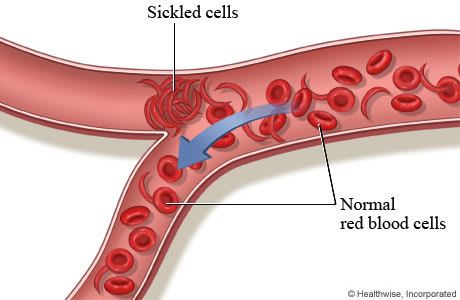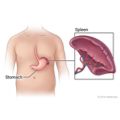Our Health Library information does not replace the advice of a doctor. Please be advised that this information is made available to assist our patients to learn more about their health. Our providers may not see and/or treat all topics found herein. Sickle cell disease is a genetic red blood cell disorder. It changes normal, round red blood cells into cells shaped like crescent moons. Sickled cells can get stuck in blood vessels and block them, which stops oxygen from getting through. That can cause a lot of pain and can harm organs, muscles, and bones. Normal red blood cells move easily through blood vessels, taking oxygen to every part of your body. People who have sickle cell disease have mostly curved (sickled) red blood cells. These cells can get stuck and block blood flow through a blood vessel. That means red blood cells and oxygen can't flow to some parts of the body. Sickle cell disease is inherited, which means it is passed from parent to child. To get sickle cell disease, a child has to inherit two sickle cell genes—one from each parent. These sickle cell genes are defective hemoglobin S genes. Painful events (sickle cell crises) in the hands or feet, belly, back, or chest are the most common symptom of sickle cell disease. This pain may last from hours to days. Most people with sickle cell disease are anemic, which can make them feel weak and tired. Sickle cell disease is diagnosed when a simple blood test shows abnormal hemoglobin. A sickle cell test looks for sickle cell trait and sickle cell disease. Treatment involves getting routine tests to monitor health, managing pain events (sickle cell crises) with medicine, and treating related health problems as they arise. Some people need regular blood transfusions to lower the risk of stroke and to treat anemia and other problems. Health Tools help you make wise health decisions or take action to improve your health. Sickle cell disorders are inherited. That means they are passed from parent to child. Children with sickle cell disease have two defective hemoglobin S genes, one from each parent. Various forms of sickle cell disorders occur when a person inherits one hemoglobin S gene (sickle cell gene) from one parent and one other type of defective hemoglobin gene from the other parent. Normally, a person inherits two genes that tell the body to produce normal hemoglobin A. One gene comes from each parent. People who inherit one defective hemoglobin S gene and one normal hemoglobin A gene have sickle cell trait. These people rarely have symptoms of sickle cell disease. Their bodies don't make sickled blood cells. But, as carriers, they can pass the defective hemoglobin S gene to their children. Painful events (sickle cell crises) in the hands or feet, belly, back, or chest are the most common symptom of sickle cell disease. They are periods of pain that happen when sickled cells get stuck in blood vessels and block the blood flow. This pain may last from hours to days. Most people with sickle cell disease are anemic. Anemia can make you feel weak and tired. People with sickle cell anemia may look pale or washed out. They may be short of breath. Their skin and the whites of their eyes may have a yellowish look (jaundice). When a child is born with sickle cell disease, it's impossible to predict which problems will develop, when they will start, or how bad they will be. During the first 6 months of life, infants have a high level of fetal hemoglobin (HbF) in their blood, which protects them from red blood cell sickling. But dangerous complications of sickle cell disease may quickly develop between ages 6 months and 5 years, after levels of fetal hemoglobin decrease. Older children and adults with sickle cell disease may have few problems. Or they may have a pattern of ongoing complications that shortens their lives. The most common and serious problems caused by sickle cell disease are anemia, pain, and organ failure. Sickle cell disease may cause problems such as: Other problems include: Call 911 anytime you or your child may need emergency care. For example, call if you or your child has: NOTE: If you or your child is having symptoms of a heart attack, the 911 operator may have you or your child chew 1 adult-strength or 2 to 4 low-dose aspirin. Wait for an ambulance. Do not try to drive yourself. Call your doctor now or seek immediate medical care if you or your child has: Make a pain management plan with your doctor that includes where and when to get treatment in case of a sickle cell emergency. Watch closely for changes in your or your child's health, and be sure to contact your doctor if you or your child has any problems. Sickle cell disease is diagnosed when initial blood tests show abnormal hemoglobin. A sickle cell test looks for sickle cell trait and sickle cell disease. The disease can be diagnosed soon after birth. A sample of blood is taken from the infant's heel. It's sent to a lab. There it is screened for the presence of sickle cell hemoglobin (hemoglobin S). The disease may also be diagnosed based on the problems it can cause. More testing may be done if needed. Doctors can diagnose sickle cell disease before a child is born (prenatally). Prenatal tests include amniocentesis and chorionic villus sampling (CVS). Couples who are at risk for passing on this disease to their children may want to talk with a genetic counselor about prenatal testing before getting pregnant. Medical treatment can help you manage pain and avoid other health problems from sickle cell disease. Early treatment includes daily antibiotics from 2 months to 5 years of age to help prevent infections. Childhood and adult immunizations are also important. Your doctor may also suggest you take folic acid or other supplements. Medicines that treat sickle cell disease include hydroxyurea and pain medicines. You may need a prescription for some of the medicines. Others you can buy over-the-counter. Pain medicine may work best when you also do other things to manage pain. You can prepare for painful events ahead of time by creating a pain management plan with your doctor. Some people need regular blood transfusions to lower the risk of stroke and to treat anemia and other problems. Some people take prescription medicine, such as L-glutamine, to prevent problems. In rare cases, a stem cell transplant might be an option. In many cases, you can treat mild to severe sickle cell pain at home. You can use a combination of pain medicines, plenty of fluids, and comfort measures such as heating pads or hot water bottles. Do not use heating pads with children. A painful event (crisis) can become severe and may last for days to weeks. If home treatment doesn't help enough, you'll need strong pain medicine that must be monitored in a hospital or treatment center. Here are some things you can do to help prevent problems when you or your child has sickle cell disease. If you have sickle cell disease, you can take steps to treat pain at home. You can take steps to help your child cope at school with the special needs of having sickle cell disease. Current as of: October 7, 2025 Author: Ignite Healthwise, LLC Staff Current as of: October 7, 2025 Author: Ignite Healthwise, LLC Staff Clinical Review Board This information does not replace the advice of a doctor. Ignite Healthwise, LLC disclaims any warranty or liability for your use of this information. Your use of this information means that you agree to the Terms of Use and Privacy Policy. Learn how we develop our content. To learn more about Ignite Healthwise, LLC, visit webmdignite.com. © 2024-2025 Ignite Healthwise, LLC.Sickle Cell Disease
What is sickle cell disease?
How does it affect your body?

What causes sickle cell disease?
What are the symptoms?
How is it diagnosed?
How is sickle cell disease treated?
Health Tools
Cause
Symptoms
What Happens
Complications
Learn more
When to Call a Doctor
Learn more
Exams and Tests
Learn more
Treatment Overview
Treating pain
Learn more
Self-Care
Treating pain
Managing your child's at-school needs
Learn more
Related Information
Credits
Clinical Review Board
All Ignite Healthwise, LLC education is reviewed by a team that includes physicians, nurses, advanced practitioners, registered dieticians, and other healthcare professionals.
All Ignite Healthwise, LLC education is reviewed by a team that includes physicians, nurses, advanced practitioners, registered dieticians, and other healthcare professionals.
Our Health Library information does not replace the advice of a doctor. Please be advised that this information is made available to assist our patients to learn more about their health. Our providers may not see and/or treat all topics found herein. Current as of: October 7, 2025 Author: Ignite Healthwise, LLC Staff Clinical Review BoardSickle Cell Disease
All Ignite Healthwise, LLC education is reviewed by a team that includes physicians, nurses, advanced practitioners, registered dieticians, and other healthcare professionals.




